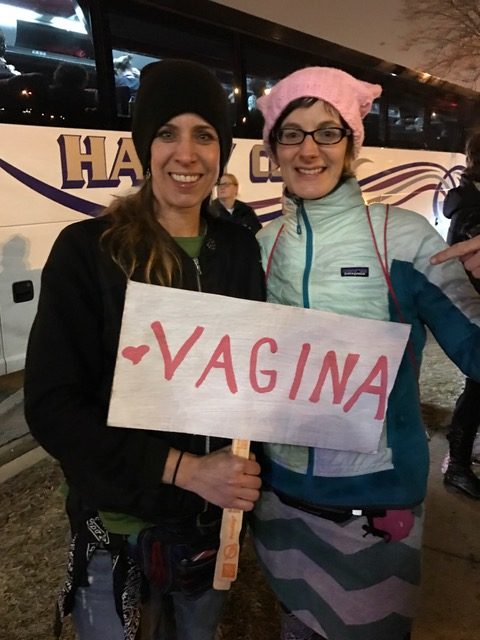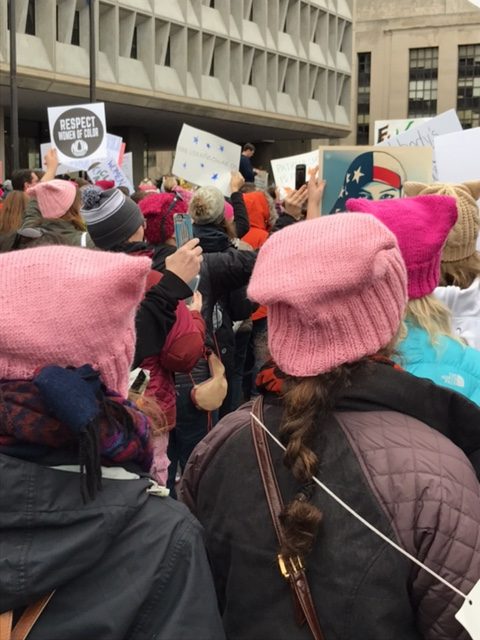The Women’s March on Washington: A practical resistance
17 February 2017 – Melissa Marietta

Melissa Marietta (right) and a friend preparing for the Women’s March on Washington. Photo credit: Melissa Marietta
On November 9th, I put my kids on the bus and cried in the shower. I was embarrassed by my own visceral reaction to the news of the election and tried to recover for my day in the office. What I soon discovered, however, was that I was not alone in my shock, grief and anger. A few weeks later, when I learned that a march was being planned in D.C. for the day after the inauguration, I didn’t think twice about signing myself up to participate. For the first time in my life. Like many others (before the march none of us had any idea just how many others) newbie marchers joined with seasoned protesters to participate in the largest march in modern times.
I reflect here on my own experience as a demonstrator and emphasize to historians the importance of the things we carried that day.
My biggest material culture lesson from the Women’s March on Washington (WMOW) is to dress the part. Historically, dress has been an integral aspect of protest material culture. As a protester, the act of marching is an impactful, theatrical, political performance. The costuming, accessories, scenery, words and music all come together to make a defining sensory statement to the intended audience.
In the article, “Protesters, You Better Dress for Success,” author Craig Mills provides us with a synopsis of the importance of protest attire and the message it conveys about the wearer. What you wear, or don’t wear, sends a strong message both to those protesting and those observing the protests. For example, Mills argues that at the turn of the century, suffragettes matched their political demands with the “new woman” look, which included less restrictive undergarments, and wore white, purple, and green at marches. The Black Panthers’ berets and fatigues were both unapologetic and provocative statements. Mills also writes that the Panthers’ clothing and actions alienated those who might have otherwise sympathized with the movement. As much as protest clothing sends messages to the observer, to those within the protests, the uniformity of costume says, “I belong here, too.”
During the early stages of planning, the organizers of the WMOW garnered quick criticism regarding lack of intersectionality and inclusivity. In response, they quickly diversified their leadership and spoke transparently about the WMOW as a march for all. The march’s unity principles countered critiques of alienation, clearly defining support of “Black women, Native women, poor women, immigrant women, disabled women, Muslim women, lesbian queer and trans women.” This inclusivity, however, alienated some white women, who questioned their place in the march, feeling they did not belong, even if the march was for “all humans.”
So what does protest costume and attire look like for hundreds of thousands of protesters seeking common ground while not diminishing marginalized voices? What would marchers from such diverse backgrounds, with unique and individual march motives, wear that would say, “I belong here, too”?
The WMOW took place in the northeast in January. March costume is not only an act of performance, it is practical, and mind you,”Black women, Native women, poor women, immigrant women, disabled women, Muslim women, lesbian queer and trans women” and white women are practical. What did that mean for WMOW protest attire? Marchers wore a hat, specifically a pussy hat.

Pussy hats worn by protesters during the Women’s March on Washington. Photo credit: Melissa Marietta
A material culture record of the WMOW would not be complete without the pussy hat. As captured in a simple yet powerful image on the cover of Time magazine, the hat is a critical part of the legacy of the WMOW and serves as a symbol of the resistance and democracy in action mixed with practicality. The pussy hat, worn by a majority of marchers, made by knitters across the country and donated to the cause, is a message of marginalized groups “taking back,” and mostly, a unifier for marchers, who despite their differences in race, age, religion, economic status, and motive for marching, could don the hat and say, “I belong here and so do you.” The sea of pink also showed that women protesters are practical planners and many (though not all) are moms. We wear hats in the winter and we make sure our kids do, too. WMOW 101: use common sense when practicing political resistance.
However, what might be the most overlooked symbol of the WMOW, and use of common sense during resistance, is the clear, plastic backpack. The backpack, as prevalent at the march as the pussy hat, and regulated by organizers to be no larger than 17″ x 12″ x 6’’, demonstrates a global climate of fear and the push for transparency in matters related to security at mass gatherings. In his article, “How the Trump Inaugural Cleaned Out Amazon’s Clear Backpack Supply”, author Galen Moore cites the clear backpack’s rise in use by the general population post-Columbine, post-Boston Marathon, post-Berlin attack and the seriousness with which marchers took the advice of organizers, selling out the stock of national online retailer Amazon.
In the article “What It really means to wear a clear backpack to the women’s march,” Rory Satran reminds readers of the fashionable, and somewhat odd, popularity of the plastic backpack of the 1990s, an item used by ravers and proudly sported by teenage girls along with plastic barrettes and knee socks. Satran also references the darker side of the clear bag, when its use is imposed, as is was on high school students at an Annapolis school who felt the mandatory clear bag was a sign of lack of trust. As Satran so articulately states, “the clear backpack sends a mixed message. It’s both a fashionable counterculture symbol and a symptom of oppression.”
Dr. Edythe Ann Quinn, author, professor of history at Hartwick College, a colleague of mine and a seasoned protester, shared this observation in a recent email conversation: “The backpack is a metaphor for the WMOW: clear, even transparent, individual motivations for personal and local and national well being. And common resistance. What are we about; just look inside us, our dreams, our hopes, our faith, our anger. Nothing is hidden. We invite you to look.”
Politicians and historians: start taking notes. You can’t miss us with our chants, our signs, our pussy hats and our clear backpacks. Our motives are bright and clear. The movement is here.



